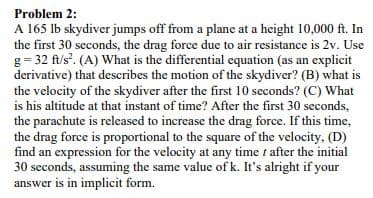Problem 2: A 165 lb skydiver jumps off from a plane at a height 10,000 ft. In the first 30 seconds, the drag force due to air resistance is 2v. Use g= 32 ft/s'. (A) What is the differential equation (as an explicit derivative) that describes the motion of the skydiver? (B) what is the velocity of the skydiver after the first 10 seconds? (C) What is his altitude at that instant of time? After the first 30 seconds, the parachute is released to increase the drag force. If this time, the drag force is proportional to the square of the velocity, (D) find an expression for the velocity at any time t after the initial 30 seconds, assuming the same value of k. It's alright if your answer is in implicit form.
Problem 2: A 165 lb skydiver jumps off from a plane at a height 10,000 ft. In the first 30 seconds, the drag force due to air resistance is 2v. Use g= 32 ft/s'. (A) What is the differential equation (as an explicit derivative) that describes the motion of the skydiver? (B) what is the velocity of the skydiver after the first 10 seconds? (C) What is his altitude at that instant of time? After the first 30 seconds, the parachute is released to increase the drag force. If this time, the drag force is proportional to the square of the velocity, (D) find an expression for the velocity at any time t after the initial 30 seconds, assuming the same value of k. It's alright if your answer is in implicit form.
Related questions
Question

Transcribed Image Text:Problem 2:
A 165 lb skydiver jumps off from a plane at a height 10,000 ft. In
the first 30 seconds, the drag force due to air resistance is 2v. Use
g = 32 ft/s'. (A) What is the differential equation (as an explicit
derivative) that describes the motion of the skydiver? (B) what is
the velocity of the skydiver after the first 10 seconds? (C) What
is his altitude at that instant of time? After the first 30 seconds,
the parachute is released to increase the drag force. If this time,
the drag force is proportional to the square of the velocity, (D)
find an expression for the velocity at any time t after the initial
30 seconds, assuming the same value of k. It's alright if your
answer is in implicit form.
Expert Solution
This question has been solved!
Explore an expertly crafted, step-by-step solution for a thorough understanding of key concepts.
This is a popular solution!
Trending now
This is a popular solution!
Step by step
Solved in 5 steps
